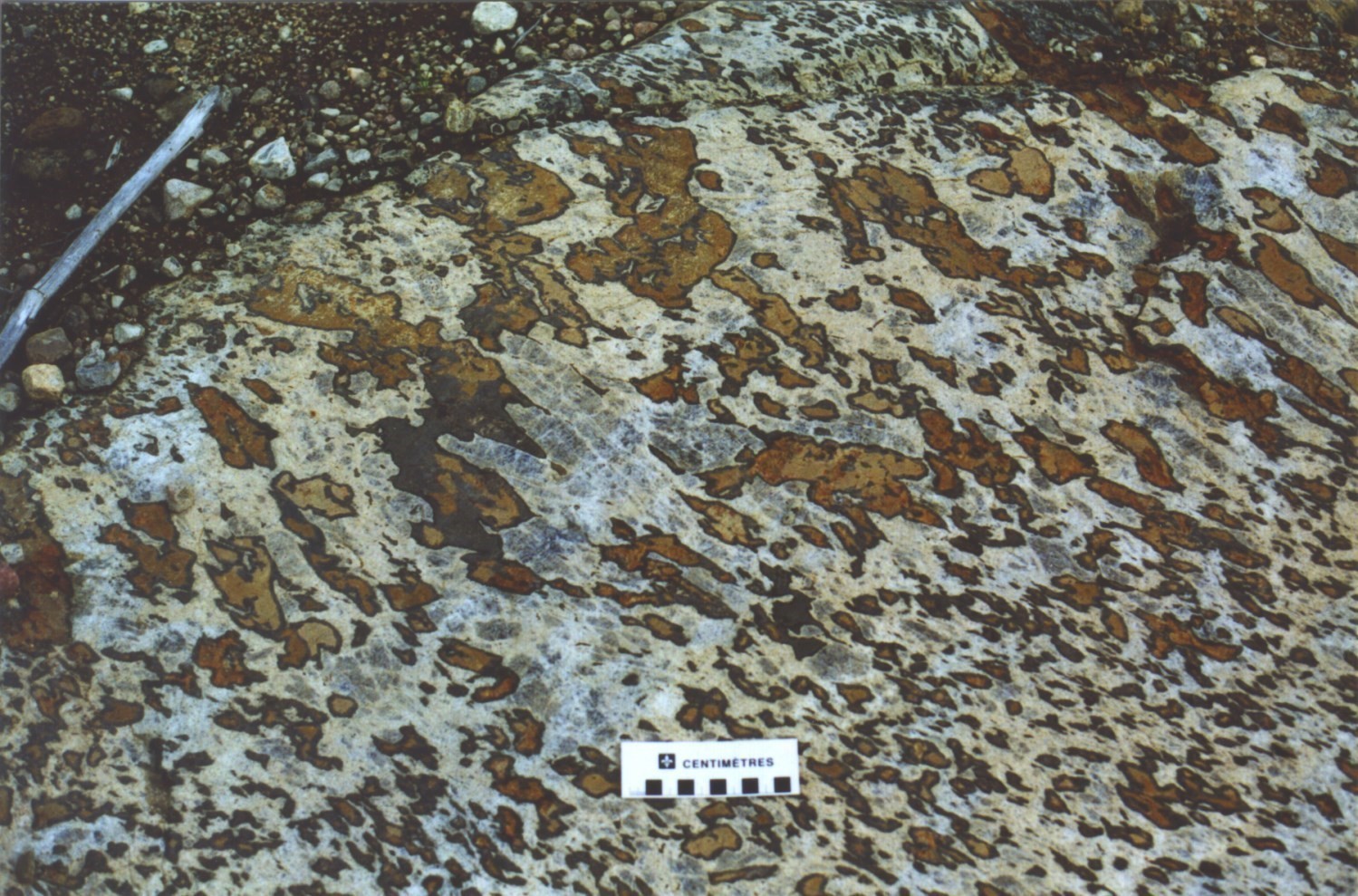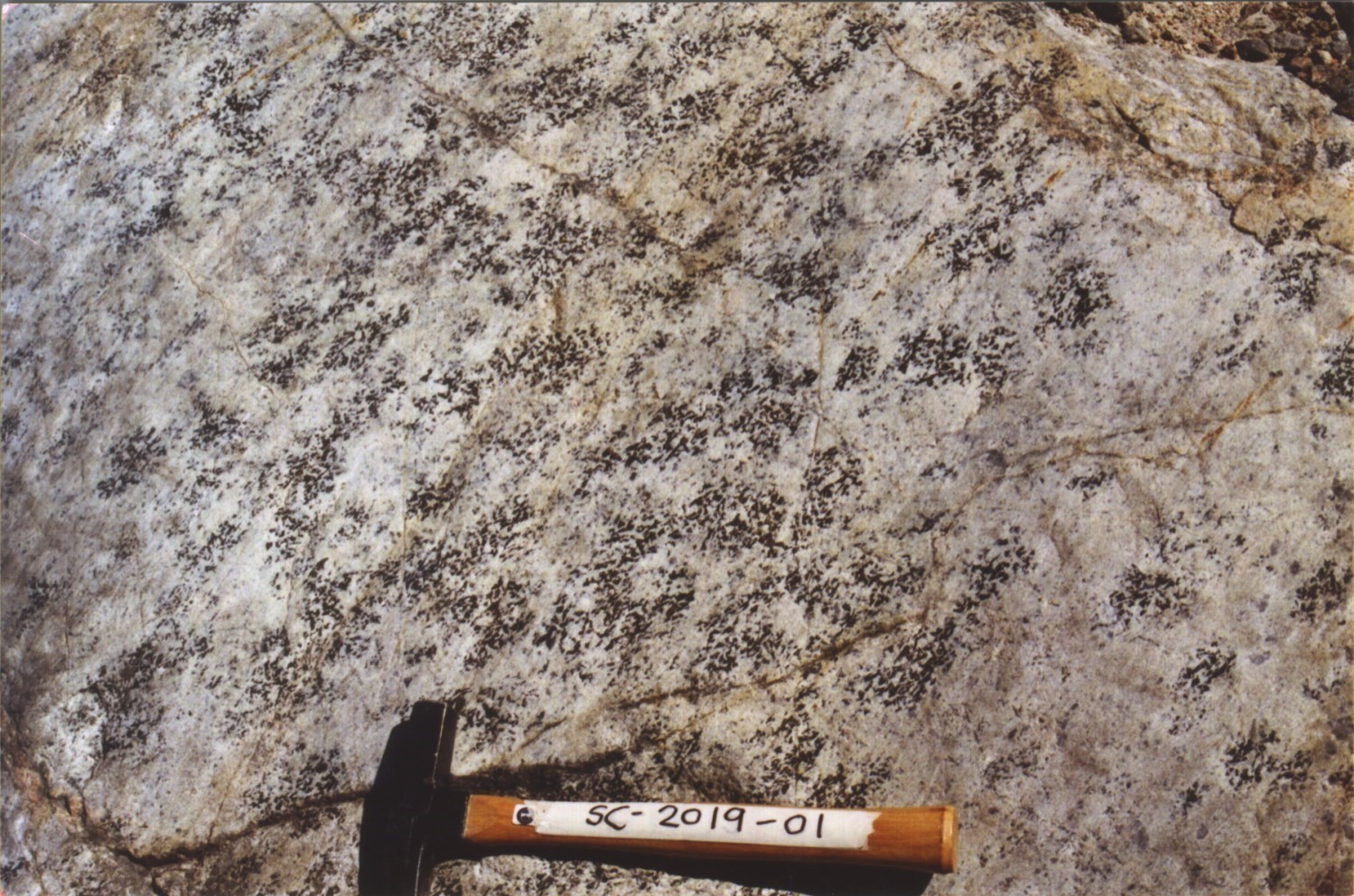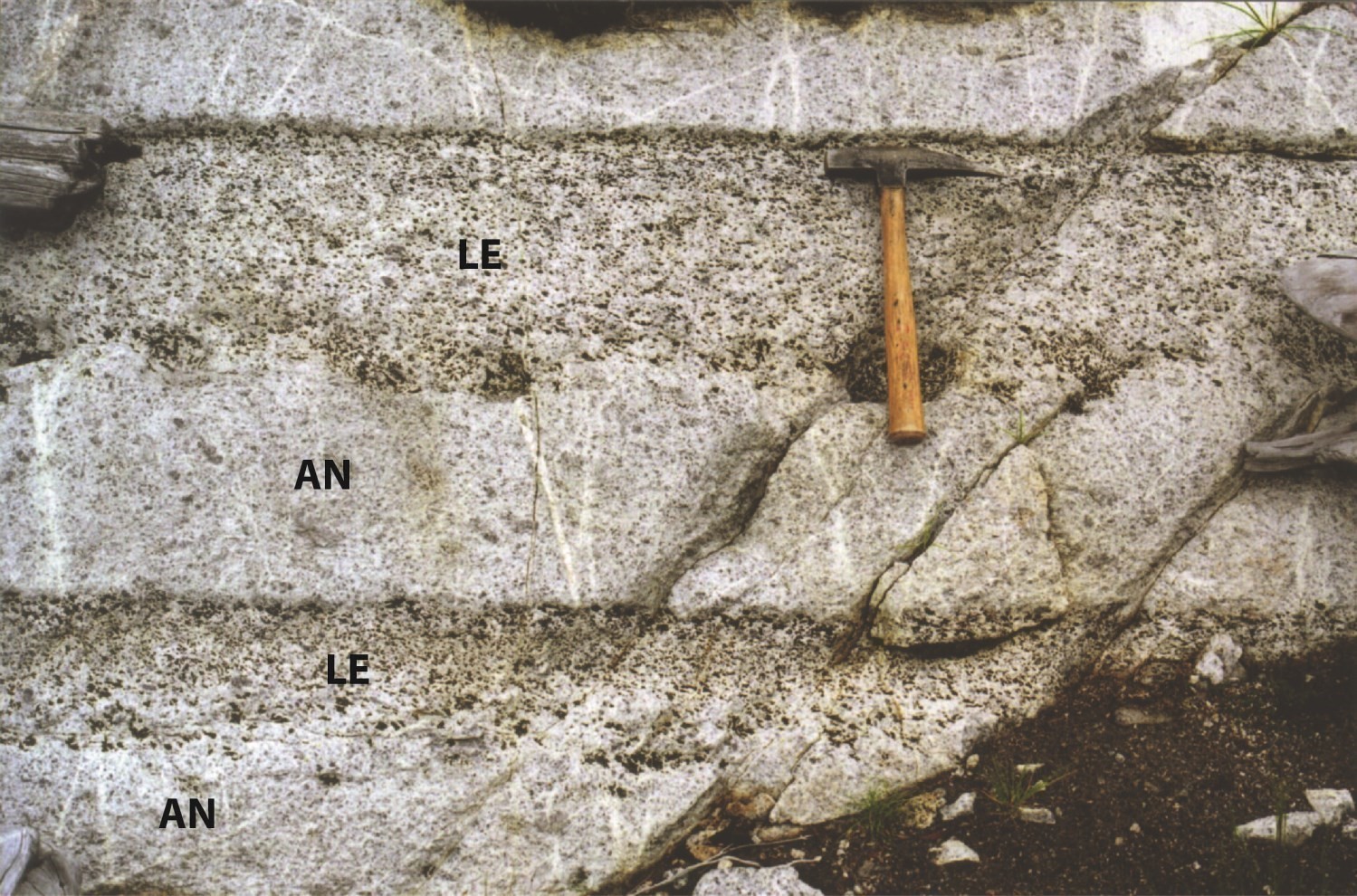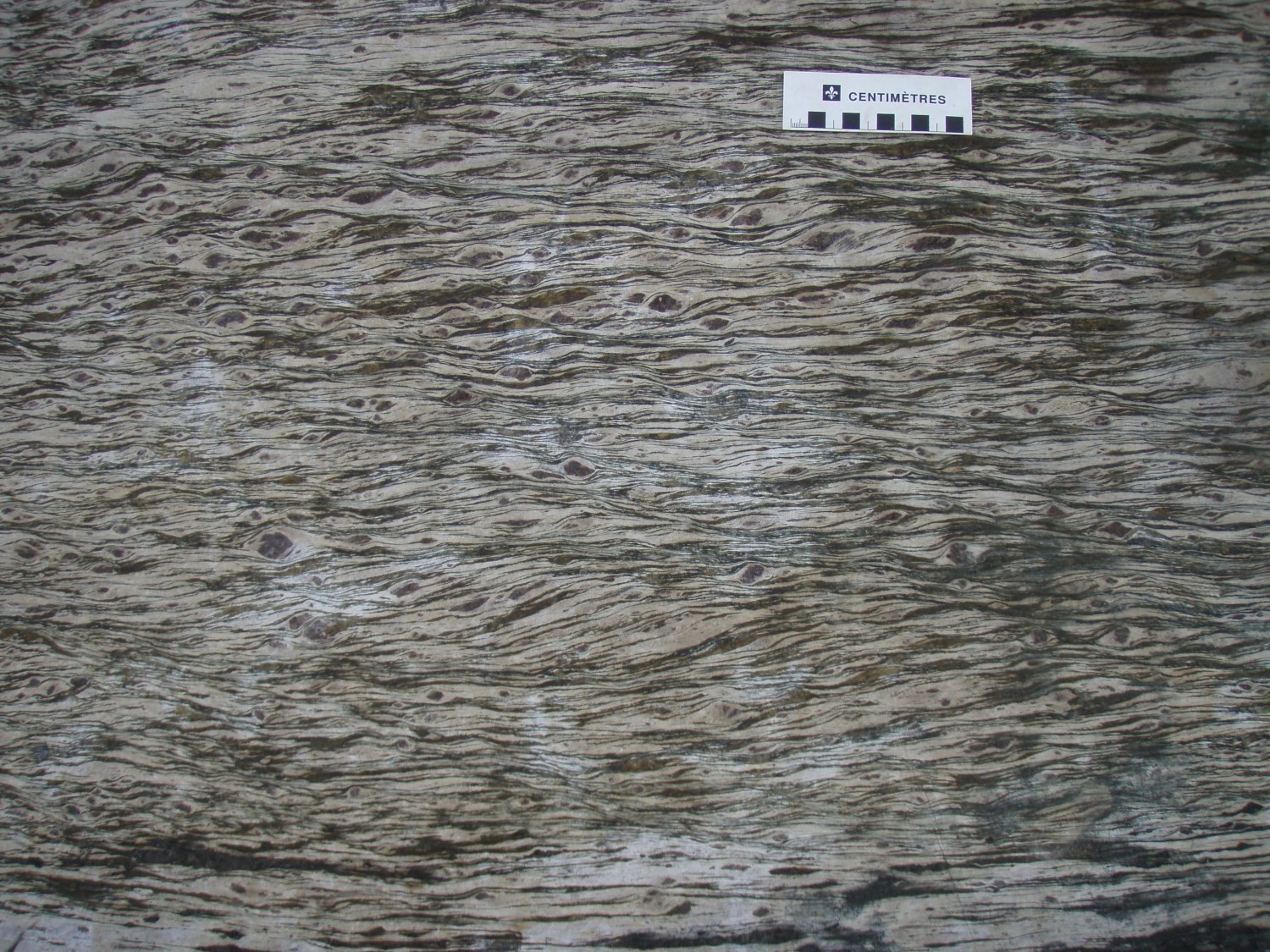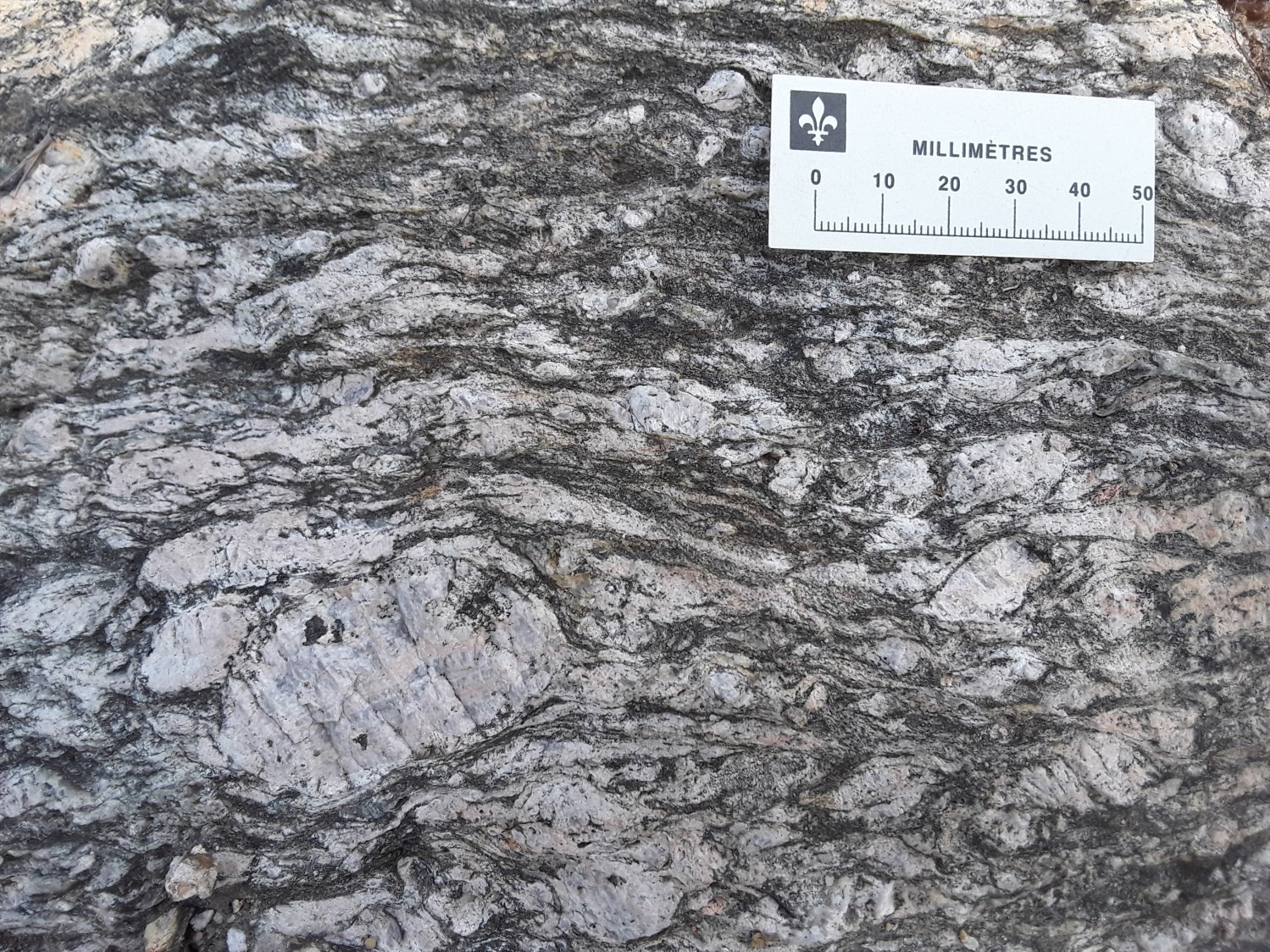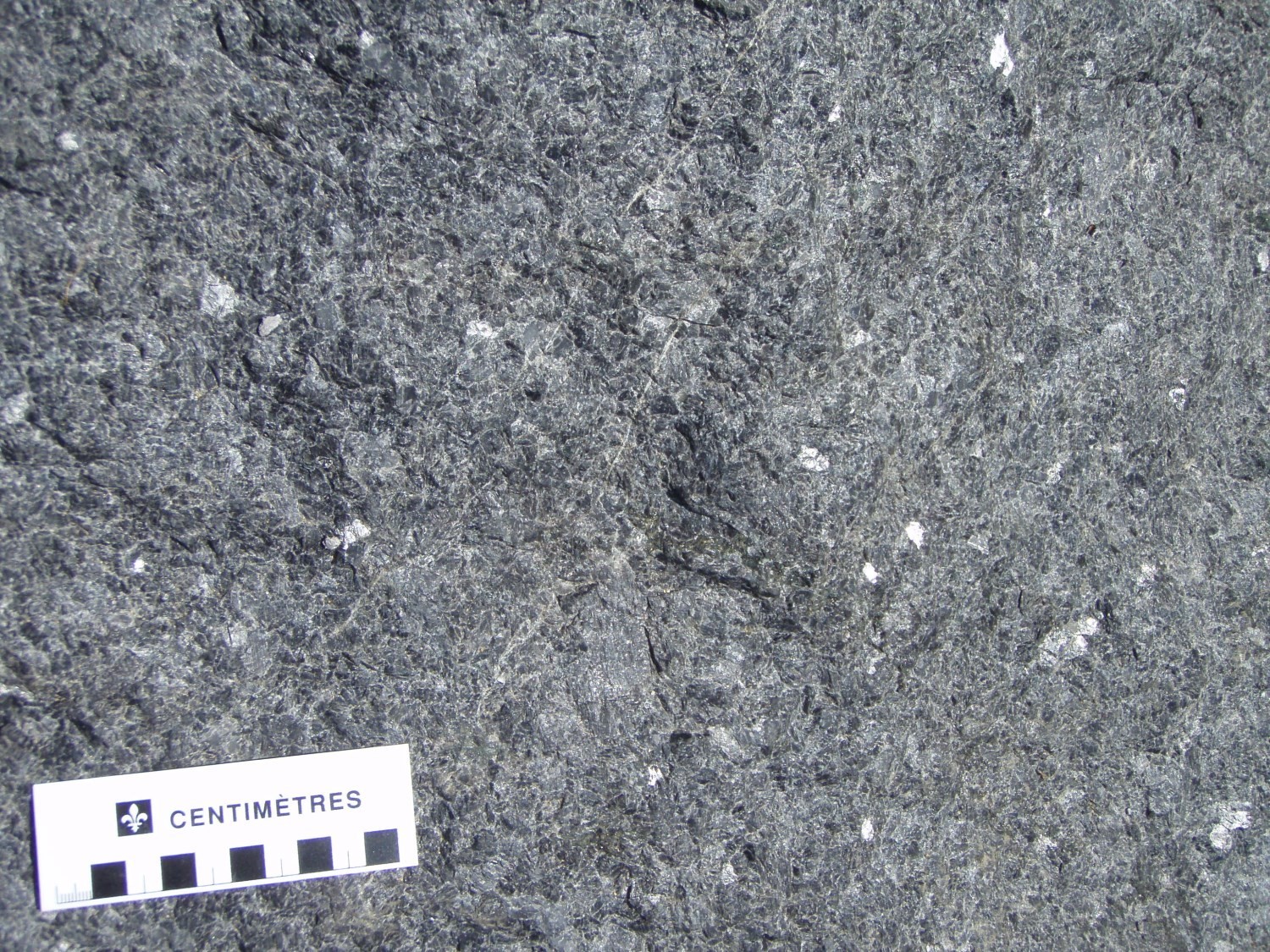
DISCLAIMER: This English version is translated from the original French. In case of any discrepancy, the French version shall prevail.
mPlsj2a Anorthosite enriched in Fe-Ti
| Author: | Laurin and Sharma, 1975 |
| Age: | Mesoproterozoic |
| Stratotype: | Lac Saint-Jean (type locality) |
| Type area: | Saguenay–Lac-Saint-Jean area, NTS sheet 22E |
| Geological province: | Grenville Province |
| Geological subdivision: | Allochton |
| Lithology: | Mafic, ultramafic and felsic plutonic rocks |
| Category: | Lithodemic |
| Rank: | Suite |
| Status: | Formal |
| Use: | Active |
Background
The main intrusive mass of the Pipmuacan Reservoir area (sheet 22E) is the Lac-Saint-Jean Anorthositic Suite (LSJAS), which covers more than 40% of the area. Previously encompassing a larger area (Laurin and Sharma, 1975), it was significantly reduced due to new geochronological data. In fact, ~20% of the initial area of this suite has been attributed to two younger anorthositic suites: the Pipmuacan Anorthositic Suite, dated 1082 Ma to 1045 Ma, and the Valin Anorrthositic Suite, dated 1016 Ma to 1008 Ma (Hébert et al., 2009).
The LSJAS was also mapped in sheet 22D by Hébert and Lacoste (1998), SSW of sheet 22F13 by Moukhsil et al. (2009), and NNE of sheet 32A08 and east of sheet 32A16, respectively south and north of Lake Saint-Jean, by Moukhsil and Daoudene (2019) and and Moukhsil and El Bourki (2020).
Descriptions of this intrusion’s lithologies are taken from the geological synthesis of sheet 22E by Hébert et al. (2009). These authors grouped the different lithologies of this suite into two main facies: a) a mafic to ultramafic facies, and b) an intermediate to felsic facies. Field observations show that several characteristics such as lithology type, primary structures, magnetite, ilmenite and apatite contents, as well as deformation are not distributed homogeneously in the LSJAS. This unit was remapped in sheets 22D10 and 22D15 during the fieldwork of Talla Takam and Moukhsil (2023).
Description
The LSJAS consists of a series of lobes emplaced through successive intrusions of magmatic phases (Hébert, 1995). The mafic to ultramafic facies contains 8 units (mPlsj1 to mPlsj8), which include anorthosite, leuconorite, troctolite, norite, gabbronorite, olivine gabbro, gabbro, pyroxenite, peridotite, dunite, magnetitite and nelsonite (Hébert et al., 2009). The intermediate to felsic facies is represented by the Du Bras Granite (mPbra) and the Patrick Ouest Charnockite (mPick) (Hébert et al., 2009).
Mafic to Ultramafic Facies
Lac-Saint-Jean Anorthositic Suite 1 (mPlsj1): Gabbronorite with or without Fe-Ti-P Oxides, Coronitic Leuconorite
Unit mPlsj1 consists mainly of gabbronorite which may contain thin horizons of coronitic leuconorite. Gabbronorite is a lithology commonly associated with anorthositic masses. Indeed, the presence of gabbronoritic fringes bordering anorthositic masses is not uncommon. Hébert and Cadieux (2003) and Hébert and Lacoste (1998) described gabbronorite horizons at the edge of the Mattawa Anorthosite, while Gobeil et al. (2002) observed these rocks on the periphery of De La Blache Mafic Plutonic Suite (NE corner of sheet 22E). Gabbronorite is brownish to greenish or black in altered surface and brownish grey or black in fresh exposure. In addition, the rock unit is homogeneous, medium grained and contains <50% coronitic orthopyroxene. Large pyroxene crystals often form strings stretched parallel to the foliation. A few Fe-Ti-P oxide gabbronorite horizons are observed in this unit.
Lac-Saint-Jean Anorthositic Suite 2 (mPlsj2): Anorthosite, Leuconorite, Gabbro, Norite, Ultramafic Rock Layers
Unit mPlsj2 is the largest unit of the LSJAS. It consists of anorthosite and leuconorite with purple, light-grey or bluish labradorite type plagioclase (Hébert et al., 2009). There are also scarce horizons of norite, gabbro, gabbronorite and pyroxenite. Anorthosite is the most common rock and is composed of >90% plagioclase (labradorite type) of centimetric to decimetric grain size, and>10% orthopyroxene (generally coronitic). Leuconorite is composed of coronitic orthopyroxene (10-35%), hornblende and biotite.
Primary bedding is easily identified in anorthosite and leuconorite. This bedding is commonly highlighted by alternating horizons of anorthosite and leuconorite of varying grain size. Individual beds vary in thickness from a few tens of centimetres to ~3 m. Horizons of anorthositic and leuconoritic magma mixing are also observed. In these mixes, leuconoritic magma forms more or less ovoid clusters, locally in negative relief relative to the surrounding anorthositic magma.
Lac-Saint-Jean Anorthositic Suite 2a (mPlsj2a): Anorthosite Enriched in Fe-Ti
Subunit mPlsj2a consists mainly of anorthosite enriched in Fe-Ti. However, it is characterized by the presence of thin horizons of pyroxenite and ilmenite magnetitite, as well as low apatite content. Chalcopyrite, pyrite and pyrrhotite mineralizations are present (Hébert and Beaumier, 2000).
Lac-Saint-Jean Anorthositic Suite 2b (mPlsj2b): Anorthosite and Leuconorite Displaying Bluish Plagioclase, Locally Grey, Porphyroclastic
The unit mPlsj2b consists of anorthosite and leuconorite containing bluish plagioclase, locally greyish. It is distinguished by a plagioclase porphyroclastic texture and weak plagioclase recrystallization. In addition to pyroxenite and ilmenite magnetitite, Hébert and Beaumier (2000) identified peridotite, olivine gabbro and some dunite horizons in this subunit, as well as high apatite content (2-20%).
Lac-Saint-Jean Anorthositic Suite 2c (mPlsj2c): Light Grey to White Plagioclase Anorthosite and Leuconorite, Locally Speckled (Orthopyroxene), Gabbronorite Horizons Enriched in Fe-Ti Oxides
Subunit mPlsj2c consists of anorthosite and light grey plagioclase leuconorite, which locally contains orthopyroxene poikilitic phenocrystals 2 cm to 8 cm long, giving the rock a speckled appearance. Horizons of gabbronorite enriched in Fe-Ti oxides (ilmenite-magnetite) are observed. In places along the southern edge of Lake Saint-Jean (sheet 32A08), anorthosite is whitish and shows very intense plagioclase recrystallization. In sheet 22F13, the dextral Pipmuacan Shear Zone borders this unit to the south (Moukhsil et al., 2009).
Lac-Saint-Jean Anorthositic Suite 3 (mPlsj3): Leuconorite, Anorthosite
Laurin and Sharma (1975) defined this unit as a package of gabbroic anorthosite and anorthositic gabbro. These former names were replaced by “leuconorite” and “leucogabbronorite”, respectively. According to Hébert et al. (2009), unit mPlsj3 differs from unit mPlsj2 by its much higher proportion of leuconorite (70%) compared to anorthosite (30%). These authors revealed that these rocks are locally composed of andesine-type plagioclase. Andesine facies are primarily found in the north-central part of sheet 22E and are often enriched in titanomagnetite, ilmenite and apatite (Cimon and Hébert, 1998; Hébert, 2001; Hébert et al., 2005). This unit contains very thin horizons of olive leuconorite in leuconorite and norite. Olivine is always separated from plagioclase by successive rims of pyroxenes, hornblende and garnet (coronite).
Typically, ultramafic lithologies are encountered in unit mPlsj3, along with horizons of magnetitite and nelsonite. Hébert et al. (2009) specifically mention the presence of clinopyroxenite in the northeastern part of Pamouscachiou Lake (sheet 22E10) and orthopyroxenite in the Paul Lake area (sheet 22E15), where apatite mineralization is more associated with nelsonites and anorthositic gabbros. Peridotite and dunite horizons have been observed in Virginia Gold Mines drilling in the Paul Lake area (Francoeur, 1998, 1998; Archer et al., 1998). Peridotite and dunite typically contain Fe-Ti oxides and apatite. Magnetittie occurs as massive horizons or breccias consisting of titanomagnetite, ilmenite and apatite. In massive horizons, these minerals are medium to fine grained. In contrast, they are often coarse grained in breccias and form a mesostase that coats fragments of anorthosite, leuconorite and norite, as well as crystals or fragments of plagioclase and pyroxene. Nelsonite is composed mainly of ilmenite and apatite and some magnetite. Ilmenite is grey-black to black, while apatite can be white, yellowish or greenish. Nelsonite horizons are primarily located in the Paul Lake area where Soquem has intersected several horizons by drilling (Roy, 2001).
Lac-Saint-Jean Anorthositic Suite 4 (mPlsj4): Leuconorite
Unit mPlsj4 is primarily found in the SW portion of sheet 22E. It consists mainly of leuconorite (anorthositic gabbro), accompanied by minor amounts of norite, diorite and locally anorthosite enclaves.
Lac-Saint-Jean Anorthositic Suite 5 (mPlsj5): Black to Dark Grey Olivine Gabbro and Gabbro, Massive and Highly Magnetic, Thin Peridotite Horizons and Fe-Ti-P Oxide Dunite
Unit mPlsj5 is located in the northwest portion of sheet 22E and forms a small mass of black to dark-grey, massive and highly magnetic olivine gabbro and gabbro. Gabbro contains up to 35% olivine and smaller amounts of orthopyroxene and amphibole either ferromagnesian (grunerite-type cummingtonite) or sodic and ferriferous (katophorite). Thin horizons of dunite and peridotite with Fe-Ti oxides and apatite are also observed in this unit.
Lac-Saint-Jean Anorthositic Suite 6 (mPlsj6): Fine-Grained Salt-and-Pepper Gabbro, Microcoronitic, Locally Magnetic (Steve Gabbro)
Unit mPlsj6, also known informally as Steve gabbro, forms a large mass NW of the Pipmuacan Reservoir (Hébert et al., 2009). This gabbro is a late facies of the LSJAS. It is massive, medium grained, pepper-and-salt-coloured and mainly composed of clinopyroxene (augite to ferro-augite) and lesser amounts of orthopyroxene, generally microcoronitic. Locally, enclaves of anorthosite, leuconorite, gabbro, pyroxenite and oxide-enriched rocks are observed.
Lac-Saint-Jean Anorthositic Suite 7 (mPlsj7): Intrusive Breccia with Leucogabbroic Matrix and Angular Fragments of Anorthosite, Leuconorite, Gabbronorite, Norite and Gabbro
Unit mPlsj7 is a magmatic breccia zone consisting of angular fragments of anorthosite, leuconorite, gabbronorite and melanorite in a leuconorite matrix. Michaud (2002) proposes that this magmatic breccia zone corresponds to a magmatic chamber that has formed within previously consolidated leuconorite horizons. Locally, diorite and leucogabbronorite occurring as mutually cutting dykes contain highly recrystallized anorthosite and leuconorite blocks (Fredette, 2006).
Lac-Saint-Jean Anorthositic Suite 8 (mPlsj8): Brecciated Gabbro Including Calcosilicate Rock and Marble Enclaves
Unit mPlsj8 consists of a brecciated gabbro with calcosilicate rock and marble enclaves (Gervais, 1993). These enclaves are up to 10 m long and originate from units of the Saint-Onge Supracrustal Sequence (paragneiss, marble, calcosilicate rock, quartzite), which outcrops nearby.
Intermediate to Felsic Facies
Du Bras Granite (mPbra)
This unit of locally bluish-quartz granophyre was named Du Bras Pluton by Beisswenger (1992). Granophyre is believed to be the result of partial melting of the host paragneiss during the emplacement of anorthositic rocks of the LSJAS. Ider (1997) and Higgins et al. (2002) obtained an age of 1148 ±6 Ma for the granophyre, confirming its belonging to the LSJAS. These authors renamed this unit the Du Bras Granite.
Patrick Ouest Charnockite (mPick)
This intrusion was described by Gervais (1993) and was dated by van Breemen (2009) to 1143 ±2 Ma. It consists of charnockite and mangerite. Charnockite is slightly pinkish beige in fresh and altered surfaces. It contains K-feldspar phenocrystals that are found in a low-abundance matrix of quartz, feldspar and biotite, so that these minerals appear stacked on top of each other. Charnockite is coarse grained, porphyraceous and shows a rapakivi texture. Mangerite outcrops in the southern portion of the intrusion. It is greenish in fresh exposure and porphyraceous. Unlike charnockite, feldspar phenocrystals are incorporated in an abundant matrix (>50%).
Moukhsil and El Bourki (2020) mapped alkali feldspar granites (NE portion of sheet 32A16) that make up the SW envelope of the Lac-Saint-Jean Anorthositic Suite. Alkali feldspar granite is greyish in altered surface and pinkish in fresh exposure. It is K-feldspar porphyraceous (1-5 cm), perthitic and locally with a rapakivi texture. It is also composed of large zones of quartz, plagioclase, orthopyroxene, green hornblende, clinopyroxene and biotite. In places, orthopyroxene is uralitized and associated with some clinopyroxene crystals, all encompassed by perthitic K-feldspar phenocrystals. Accessory minerals are zircon, magnetite and titanite.
Thickness and Distribution
The Lac-Saint-Jean Anorthositic Suite covers an area of 20 000 km2, making it one of the most important intrusions in the Grenville Province.
Dating
Dating of several samples belonging to the LSJAS was estimated to be between 1160 Ma and 1135 Ma. Dating of an alkali feldspar granite sample from the Patrick Ouest Charnockite (outcrop 19-AM-92) collected during the work of Moukhsil and El Bourki (2020) delivered a preliminary age of 1169.12 Ma, therefore older than previously obtained. This suggests that the Patrick Ouest Charnockite is the host of LSJAS mafic to ultramafic facies. Although preliminary, this age could mean that the LSJAS would have been emplaced in the range of 1169 Ma to 1135 Ma and coincided with the Adirondian event (1180-1080 Ma) of Gower and Krogh (2002).
| Unit | Sample Number | Isotopic System | Mineral | Crystallization Age (Ma) | (+) | (-) | Reference(s) |
| mPbra and several other intrusions | – | U-Pb | Zircon | 1160-1135 |
Higgins and van Breemen, 1996; Hébert et al., 2009 |
||
| mPlsj2c | 2008-AM-0016A | U-Pb | Zircon | 1159 | 12 | 8 | David et al., 2010 |
| mPick1 | Heb-Charnockite-01 | U-Pb | Zircon | 1143.5 | 1.2 | 1.2 | Van Breenen, 2009 |
| mPick1 | 2019-AM-92A | U-Pb | Zircon | 1169 | 14 | 14 | Papapavlou, 2020 |
Stratigraphic Relationship(s)
Intrusion of the Lac-Saint-Jean Anorthositic Suite involves multiple rises of mafic to ultramafic magmas. These magmatic impulses have subsequently been involved in large Grenvillian overthrusts (Hébert et al., 2009; Turcotte, 2001). The architecture of the LSJAS is a result of several major fault zones that helped cut the suite into many juxtaposed slices.
Paleontology
Does not apply.
References
Publications Available Through Sigéom Examine
ARCHER, P., LEVESQUE, S., FRANCOEUR, G. 1998. RAPPORT DES TRAVAUX 1998, PROJET CHUTE-DES-PASSES. SERVICES TECHNIQUES GEONORDIC INC, MINES D’OR VIRGINIA INC. Assessment work submitted to the Government of Québec. GM 56578, 83 pages and 10 plans.
CIMON, J., HEBERT, C. 1998. SEQUENCES DIFFERENCIEES ASSOCIEES AU MASSIF ANORTHOSITIQUE DE LAC-SAINT-JEAN, ORIGINE, MISE EN PLACE ET IMPLICATIONS ECONOMIQUES. MRN. MB 98-09, 23 pages.
DAVID, J., MOUKHSIL, A., DION, C. 2010. DATATIONS U-PB EFFECTUEES DANS LA PROVINCE DE GRENVILLE EN 2008-2009. MRNF, GEOTOP UQAM. RP 2010-10, 17 pages.
DAVID, J., MOUKHSIL, A., DION, C. 2011. U-PB DATING IN THE GRENVILLE PROVINCE IN 2008-2009. MRNF. RP 2010-10(A), 1 page.
FRANCŒUR, G. 1998. RAPPORT DES TRAVAUX 1997, PROJET CHUTE-DES-PASSES. MINES D’OR VIRGINIA INC, FONDS MINIER DU SAGUENAY–LAC-SAINT-JEAN. Assessment work submitted to the Government of Québec. GM 56023, 259 pages and 15 plans.
GERVAIS, R. 1993. RAPPORT GEOLOGIQUE DE LA REGION DU LAC AUX GRANDES POINTES. MRN. MB 93-14, 123 pages.
HEBERT, C. 2001. GEOLOGIE DE LA REGION DE LAC MELONEZE (SNRC 22E10). MRN. RG 2001-02, 27 pages and 1 plan.
HEBERT, C., BEAUMIER, M. 2000. GEOLOGIE DE LA REGION DU LAC A PAUL (22E/15). MRN. RG 99-05, 34 pages and 1 plan.
HEBERT, C., LACOSTE, P. 1998. GEOLOGIE DE LA REGION DE BAGOTVILLE (22D/07). MRN. RG 97-06, 24 pages and 1 plan.
HEBERT, C., VAN BREEMEN, O., CADIEUX, A M. 2009. REGION DU RESERVOIR PIPMUACAN, (SNRC 22 E): SYNTHESE GEOLOGIQUE. MRNF, COMMISSION GEOLOGIQUE DU CAN. RG 2009-01, 59 pages and 1 plan.
LAURIN, A F., SHARMA, K N M. 1975. REGION DES RIVIERES MISTASSINI, PERIBONCA, SAGUENAY (GRENVILLE 1965-1967). MRN. RG 161, 103 pages and 10 plans.
MOUKHSIL, A., LACOSTE, P., GOBEIL, A., DAVID, J. 2009. SYNTHESE GEOLOGIQUE DE LA REGION DE BAIE-COMEAU (SNRC 22F). MRNF, GEOTOP UQAM-MCGILL. RG 2009-03, 30 pages and 1 plan.
MOUKHSIL, A., DAOUDENE, Y. 2019. Geology of the Commissaires Lake Area, Grenville Province, Saguenay–Lac-Saint-Jean Region, Quebec, Canada. MERN. BG 2019-01, 1 plan.
MOUKHSIL, A., EL BOURKI, M. 2020. Geology of the Normandin Area, Grenville Province, Saguenay–Lac-Saint-Jean Region, Quebec, Canada. MERN. BG 2020-01, 1 plan.
PAPAPAVLOU, K., 2020. U-Pb geochronology report, Grenville 2019-2020. UQAM; MB 2020-09, 25 pages.
ROY, I. 2001. RAPPORT SUR LA CAMPAGNE DE FORAGE, JUIN 2000, PROJET CHUTE DES PASSES 1279. SOQUEM INC, MINES D’OR VIRGINIA INC. Assessment work submitted to the Government of Québec. GM 58807, 191 pages and 9 plans.
TALLA TAKAM, F., MOUKHSIL, A., 2023. Géologie de la région du lac Jalobert, Province de Grenville, région du Saguenay-Lac-Saint-Jean, Québec, Canada. MRNF; BG 2023-11, 1 plan.
VAN BREEMEN, O. 2009. REPORT ON THE U-PB GEOCHRONOLOGY FOR THE PIPMUACAN RESERVOIR REGION. GEOLOGICAL SURVEY OF CANADA. MB 2009-04, 13 pages.
Other Publications
BEISSWENGER, A., 1997. The origin of the canton Saint-Onge wollastonite deposit, Lac-Saint-Jean, Québec. Master’s thesis, Université du Québec à Chicoutimi; 143 pages.
REDETTE, J., 2006. Pétrographie, géochimie et potentiel économique en Fe-Ti-P du secteur du Lac à Paul, partie nord de la suite anorthositique de Lac-Saint-Jean, province de Grenville, Québec. Master’s thesis, Université du Québec à Chicoutimi, Québec; 304 pages.
HÉBERT, C., CADIEUX, A.-M., VAN BREEMEN, O., 2005. Temporal evolution and nature of Ti-Fe-P mineralization in the AMCG suites of the south-central Grenville Province, Saguenay–Lac-Saint-Jean area, Québec, Canada. Canadian Journal of Earth Sciences; volume 42, pages 1065-1080. doi.org/10.1139/E05-050
HIGGINS, M., VAN BREEMEN, O., 1996. Three generations of anorthosite-mangerite-charnockite-granite (AMCG) magmatism, contact metamorphism and tectonism in the Saguenay-Lac-Saint-Jean region of the Grenville Province, Canada. Precambrian Research, volume 79, pages 327-346. doi.org/10.1016/0301-9268(95)00102-6
HIGGINS, M.D., MOHCINE, I., VAN BREEMEN, O., 2002. U-Pb ages plutonism, wollastonite formation, and deformation in the central part of the Lac-Saint-Jean anorthosite suite. Canadian Journal of Earth Sciences; volume 39, pages 1093-1105. doi.org/10.1139/e02-033
IDER, M., 1997. Géochronologie, géochimie et pétrologie des roches métamorphiques et ignées autour du gisement de wollastonite du canton de St-Onge. Master’s thesis, Université du Québec à Chicoutimi; 167 pages.
TURCOTTE, S., 2001. Mise en place de la portion nord-ouest de la Suite anorthositique du Lac-Saint-Jean durant le chevauchement grenvillien. Master’s thesis, Université du Québec à Chicoutimi; 204 pages.
Suggested Citation
Ministère de l’Énergie et des Ressources naturelles (MERN). Lac-Saint-Jean Anorthositic Suite. Quebec Stratigraphic Lexicon. https://gq.mines.gouv.qc.ca/lexique-stratigraphique/province-de-grenville/suite-anorthositique-de-lac-saint-jean_en [Accessed on Day Month Year].
CONTRIBUTORS
|
First publication |
Abdelali Moukhsil, P. Geo., Ph.D. abdelali.moukhsil@mern.gouv.qc.ca; Yannick Daoudene, P. Geo., Ph.D. yannick.daoudene@mern.gouv.qc.ca (redaction) Mehdi A. Guemache, P. Geo., Ph.D. (coordination); Fabien Solgadi, P. Geo., Ph.D. (critical review); Simon Auclair, P. Geo., M.Sc. (editing); Céline Dupuis, P. Geo., Ph.D. (English version); Nathalie Bouchard and Ricardo Escobar Moran (HTML editing). |
|
Revision(s) |
Abdelali Moukhsil, P. Geo., Ph.D. abdelali.moukhsil@mern.gouv.qc.ca; Mhamed El Bourki, GIT, M.Sc. mhamed.el-bourki@mern.gouv.qc.ca (redaction) Mehdi A. Guemache, P. Geo., Ph.D. (coordination); Fabien Solgadi, P. Geo., Ph.D. (critical review); Simon Auclair, P. Geo., M.Sc. (editing); Céline Dupuis, P. Geo., Ph.D. (English version); André Tremblay (HTML editing). |


